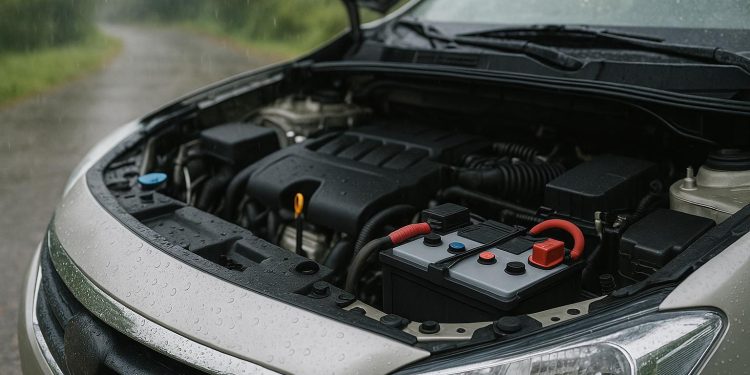Keeping your car battery in good shape during the wet season is all about preventing moisture, corrosion, and damage caused by temperature swings. Here’s a quick guide to help you avoid unexpected breakdowns:
- Inspect regularly: Check for corrosion, cracks, and loose connections on a monthly basis.
- Clean terminals: Use a baking soda paste or a battery cleaner to remove corrosion safely.
- Protect with sprays: Apply terminal sprays or dielectric grease to prevent moisture damage.
- Park smart: Use covered parking or a rain-specific car cover to reduce water exposure.
- Monitor voltage: Use a multimeter to ensure your battery stays charged (12.6V or higher when idle).
- Limit power drain: Turn off lights and unplug accessories when the engine is off.
Car Battery care tips for rainy season | पावसाळ्यात Battery ची काळजी अशी घ्या
How Wet Weather Damages Car Batteries
Wet weather can create a tough environment for your car’s battery, affecting its performance in several ways. Knowing how these factors come into play can help you take steps to protect your battery and keep it running smoothly.
Moisture and Corrosion Problems
Moisture is a key culprit in battery corrosion. During wet weather, increased humidity can lead to moisture buildup on the battery terminals. This damp environment speeds up the chemical reactions that cause corrosion. Over time, what starts as minor surface oxidation can turn into a crusty, white buildup on the terminals, which can disrupt connections between the battery posts and cables.
Road salt adds to the problem. In regions where salt is used to de-ice roads, it can find its way to your battery terminals, accelerating corrosion even further. This buildup doesn’t just look bad – it can also hinder the battery’s ability to charge efficiently, making it harder for the battery to reach full capacity over time.
Water intrusion is another major risk. If water seeps into the battery casing, it can create electrical shorts by allowing current to flow along unintended paths. This can lead to serious internal damage that may permanently impair the battery.
Let’s now look at how temperature changes during wet weather impact your battery.
Temperature Changes and Battery Performance
Shifting temperatures during wet weather can take a toll on your car battery. Cold weather, for instance, significantly reduces a battery’s output. At 32°F (0°C), the battery may lose up to 35% of its strength, and at 0°F (-18°C), that loss can climb to 60%. On the other hand, a battery performs at full capacity when the temperature is around 77°F (25°C).
But heat isn’t harmless either. When temperatures rise above 86°F (30°C), the internal chemical reactions inside the battery speed up, breaking down its components faster and shortening its lifespan. Wet weather makes things worse by combining high humidity with water exposure, compounding the effects of temperature changes. Rapid swings from cool mornings to warm afternoons can add even more stress to the battery, further impacting its durability.
Regular Maintenance to Protect Your Battery
Keeping up with regular maintenance during wet weather can help you catch issues early and ensure your battery stays in good shape. Aim for a monthly inspection to keep your battery functioning well throughout the rainy season.
How to Check for Battery Damage
Routine checks are key to preventing damage caused by moisture and fluctuating temperatures. Start by visually inspecting your battery. Use a flashlight to closely examine its condition.
Look for any physical damage on the battery case, such as bulging, swelling, or cracks. These can indicate heat damage or moisture getting into the battery. Leaks are another red flag that something’s wrong.
Next, take a close look at the battery terminals and cable connections. Corrosion often appears as a white, powdery buildup, which can worsen with moisture and reduce the battery’s electrical conductivity, potentially leaving your car unable to start. Tighten all connections to ensure proper electrical contact.
Check that the battery is securely fastened in its tray. A loose battery can vibrate while driving, leading to internal damage and a shorter lifespan.
If your battery isn’t sealed and maintenance-free, check the water levels and top them off with distilled water if needed. For sealed batteries, look for a State of Charge Indicator if your battery includes one.
Finally, use a voltmeter to check the battery’s voltage. A fully charged battery should read above 12.5 volts. If the voltage is lower, your battery might not be holding a proper charge.
Once you’ve inspected the battery for damage, move on to cleaning the terminals to maintain optimal performance.
How to Clean Battery Terminals Safely
Cleaning the terminals is an important step to prevent further corrosion. Before starting, put on rubber gloves and eye protection for safety.
Disconnect the battery by removing the negative (black) terminal first, followed by the positive (red) terminal. This order prevents accidental short circuits.
For basic cleaning, mix baking soda with water to create a paste. This mixture neutralizes the acidic corrosion. Apply the paste to the corroded areas and scrub gently using a steel wire brush or even an old toothbrush if that’s what you have handy. Terminal brushes are also an affordable option, costing around $4.
If the corrosion is more stubborn, a specialized battery cleaner like CRC Battery Cleaner with Acid Indicator can be a good choice. These cleaners not only neutralize acid but can also detect potential leaks.
After scrubbing, rinse the terminals thoroughly with water and dry them completely. Any leftover moisture can lead to new corrosion, so take the time to ensure everything is dry.
Once dry, apply a thin layer of petroleum jelly or a battery terminal protector to the posts and cable connections. This creates a barrier that helps protect against moisture and acid buildup, reducing the risk of future corrosion.
When reconnecting the battery, attach the positive terminal first, followed by the negative. Make sure all connections are tight and secure.
Lastly, keep the top of the battery clean and free from dirt and grime. A clean battery tray is also important for maintaining stability and performance.
Tools and Methods to Protect Your Battery
Keeping your car battery in good shape during wet weather is all about using the right tools and techniques. Moisture and corrosion can take a toll on your battery, but with the right protective products and consistent maintenance, you can extend its lifespan and ensure reliable performance.
Battery Insulation Kits and Terminal Sprays
Products like terminal sprays and protective coatings are essential for shielding your battery from the elements. These sprays form a barrier that keeps out acid fumes, road salt, moisture, and dirt – common culprits of corrosion. One standout option is NOCO NCP2, a trusted corrosion preventative that has earned a 4.7/5 star rating from over 1,600 Amazon customers.
"Stops corrosion for the life of your battery, making all surfaces impenetrable to corrosion-causing acid fumes." – NOCO
Priced at approximately $25.86 for a 12.25 oz can, this spray offers durable protection. In one review from January 2025, a customer shared their experience using NOCO on a new truck, reporting zero terminal corrosion for over eight years on a previously treated vehicle.
Another helpful product is dielectric grease, which seals connections from oxygen and corrosive gases. However, it’s crucial to clean and securely tighten connections before applying the grease. For a complete solution, the NOCO Corrosion Preventative Kit includes both terminal spray and dielectric grease for $14.99, offering an insulating layer that preserves electrical connections.
Parking in Covered Areas
Where you park your car matters when it comes to battery health. Indoor parking provides the best protection from rain and humidity, but even a carport can reduce exposure. If neither option is available, investing in a rain-specific car cover is a practical alternative.
Battery Protection Products Comparison
Here’s a quick comparison of popular battery protection products to help you decide which might work best for your needs:
| Product Category | Examples | Price Range | Advantages | Cons |
|---|---|---|---|---|
| Terminal Sprays/Coatings | NOCO NCP2, CRC Battery Terminal Protector | $14.99 – $25.86 | Easy to apply, long-lasting protection, proven results | Requires periodic reapplication, coating wears off |
| Terminal Cleaners | Schumacher Battery Terminal Cleaning Brush | Around $4.99 | Removes existing corrosion effectively, affordable | Can be messy, requires manual scrubbing, only treats current damage |
| Terminal Washers | TKDMR Anti-Corrosion Fiber Washers | Around $6.39 | Inexpensive, creates a physical barrier | Limited scope of protection, may trap gases |
| Protective Grease | Dielectric grease, Waterproof bearing grease | $5 – $15 | Seals connections, prevents gas/oxygen exposure | Can be messy, needs proper application |
The Schumacher Electric Battery Terminal Cleaning Brush is a top choice for removing corrosion, boasting a 4.7/5 star rating from over 7,500 Amazon customers. For ongoing protection, NOCO NCP2 continues to impress users, with one reviewer calling it a "must need for car owners" that "keeps battery acid from forming on connections and keeps you going".
When selecting a product, think about your budget and how much effort you’re willing to put into maintenance. Terminal sprays offer excellent long-term protection with minimal upkeep, while cleaning brushes and washers are more affordable but require more frequent attention.
sbb-itb-7bc66b5
How to Prevent Battery Drain in Wet Weather
Rainy conditions can take a toll on your car’s electrical system, making it essential to keep an eye on your battery’s performance and minimize unnecessary power usage. Modern vehicles continuously draw power, which can worsen battery drain during wet weather. Taking steps to manage this can go a long way in maintaining your car’s reliability.
Test Voltage and Charging System
Before testing your battery, let the car sit idle for at least an hour. Then, using a multimeter set to 20V DC, check the voltage by placing the probes on the correct terminals. Here’s what the readings mean:
- 12.6V or higher: The battery is fully charged.
- Around 12.2V: The battery is at about 50% charge.
- Below 12V: The battery is discharged.
Next, start the engine and test again. A properly functioning alternator should show a reading between 13.8V and 14.4V while idling. If the reading is below 12.6V, there could be a charging issue. A reading of about 12.8V might indicate a problem with the wiring.
Rain can lead to corroded terminals and electrical shorts, which may drain your battery. If your multimeter shows less than 12.6V when the car is at rest, disconnect the battery and charge it overnight using a charger. Also, if the battery warning light comes on while driving, it’s wise to have the alternator tested to determine if it needs replacement.
While monitoring your battery is essential, reducing power usage when your car is parked is equally important.
Reduce Power Usage When the Engine Is Off
To prevent unnecessary battery drain, limit electrical usage while your car is parked. Modern vehicles have systems that draw power even when the engine isn’t running, so try these tips:
- Turn off all lights and unplug accessories like chargers or dash cams.
- Ensure compartments and doors are securely closed to avoid accidental power draw.
Cold temperatures, often accompanying rain, can also reduce battery efficiency. High humidity or direct water contact can lead to intermittent short circuits. To combat this, inspect your battery terminals and electrical connections regularly for signs of water damage or corrosion.
Rwanda Wet Season Battery Care Tips
Rwanda’s wet season brings its own set of challenges for car batteries. Heavy rains, fluctuating temperatures, and rough road conditions can take a toll on your vehicle’s electrical system. Without proper care, these factors can lead to unexpected breakdowns during the rainy months.
Keeping Your Battery in Check During Heavy Rains and Rough Roads
The intense downpours typical of Rwanda’s wet season can strain your car’s battery and electrical system. The combination of cold weather and damp conditions often makes it harder for batteries to perform efficiently, especially older ones. If you notice your engine cranking slower than usual or headlights dimming during rainy mornings, it might be time to check for corroded terminals or loose connections. These issues can interfere with your battery’s ability to hold and deliver power effectively.
Rough roads, often worsened by water-filled potholes, pose another threat. These conditions can loosen battery connections or even damage the internal components of your car’s battery. Moreover, waterlogged roads increase resistance, forcing your engine to work harder, which can further strain the battery. Wet surfaces also reduce tire grip, impacting energy transfer from the engine to the wheels. Regularly inspect your battery terminals and connections for signs of corrosion or water buildup to ensure it stays in good condition.
"An EV battery doesn’t die overnight. It gradually loses capacity, just like your smartphone battery." – Jean-Claude N., Kigali-based EV technician
This gradual decline applies to traditional car batteries too. By monitoring your battery’s health throughout the wet season, you can address minor issues before they escalate into major problems.
Finding Battery Care Products in Rwanda
When it comes to battery care products, there are several reliable options in Rwanda. AutoXpress Rwanda, an official Energizer car battery reseller, provides a range of battery services and products to keep your car running smoothly. For those who prefer shopping online, Ubuy Rwanda offers a variety of car care products with delivery to your doorstep. Another option is Roots Rwanda, which features a wide selection of car accessories on its platform. Some of the available items include the BYGD 300W Car Power Inverter (Rwf 85,000), a standard Car Power Inverter (Rwf 48,000), and the Black & Decker Pivot Car Vacuum Cleaner (Rwf 100,000).
For expert advice tailored to Rwanda’s unique conditions, AutoMag.RW offers recommendations to help you maintain your car battery during the rainy season. Proper care and timely checks can ensure your battery stays reliable, no matter the weather.
Conclusion: Key Steps to Keep Your Battery Working in Wet Weather
Taking care of your car battery in wet weather doesn’t have to be complicated. By sticking to a few simple practices – routine maintenance, using protective tools, and adopting smart habits – you can help your battery handle the challenges of damp and cold conditions.
Start with regular maintenance. Clean the terminals with appropriate products, check all connections, and avoid frequent short trips that don’t allow the battery to recharge fully. It’s worth noting that when temperatures dip to around 32°F, batteries can lose roughly 20% of their capacity, making clean and secure connections even more critical during wet and chilly weather.
Protective tools can go a long way in extending your battery’s life. Items like battery insulation and terminal sprays help stabilize temperature and prevent corrosion. Garrett Tortelli, Senior Merchandise Manager at Batteries Plus, emphasizes the importance of insulation:
"According to Garrett Tortelli, Senior Merchandise Manager of Batteries Plus, removing a battery’s insulating jacket can reduce its life by nearly two-thirds".
Finally, adopt smart driving habits and stay proactive. Test your battery at least twice a year – especially before the wet season kicks in – to ensure it stays dependable.
FAQs
How can I prevent my car battery from corroding during the rainy season?
To keep your car battery in good shape during the rainy season, start by giving the terminals a regular cleaning. A simple mix of baking soda and water works well for this. Once cleaned, dry the terminals completely and apply a thin coat of petroleum jelly or terminal grease to shield them from moisture.
Ensure the battery is securely mounted to minimize vibrations, which can lead to wear and tear. Regularly check for any signs of rust or corrosion, and consider using anti-corrosion sprays or protective kits for added protection. Lastly, routine upkeep and making sure the battery housing is properly sealed can help keep your battery performing reliably, even in wet conditions.
How does wet weather and changing temperatures affect my car battery?
Wet weather and sudden temperature changes can seriously affect how well your car battery performs and how long it lasts. Hot weather accelerates chemical reactions inside the battery, which can lead to faster corrosion and fluid loss. Over time, this can cause internal damage. Meanwhile, cold weather increases the battery’s resistance, making it harder to deliver power and start your car – especially on those chilly mornings.
These challenges become even more apparent during seasonal shifts. To help your battery stay in top condition, make regular maintenance a priority. Clean the terminals, check for any signs of wear, and consider using protective tools like insulation kits to shield it from extreme heat or cold. These small steps can go a long way in extending your battery’s life.
What are the best tools and products to protect my car battery from moisture and corrosion?
To keep your car battery protected from moisture and corrosion, a few simple tools and products can make a big difference. Using a battery terminal protector spray or corrosion prevention products like NOCO NCP2 can shield the terminals effectively. You can also apply petroleum jelly or WD-40 to create a barrier against moisture. If you need to clean off buildup, a paste made from baking soda and water works wonders.
It’s also important to have the right tools for the job. Keep wire brushes handy to clean the terminals, and always use safety gloves and goggles to protect yourself while working. A wrench or pliers will be useful for tightening any loose connections. With regular upkeep using these items, you can help your battery last longer, even during wet conditions.
Related posts
- Vehicle Inspection Checklist for Rwandan Drivers
- Top 5 Cheapest Cars to Maintain in Rwanda
- Common Car Problems in Rwanda (And How to Prevent Them)
- Car Overheating? Here’s What Rwandan Drivers Should Know





